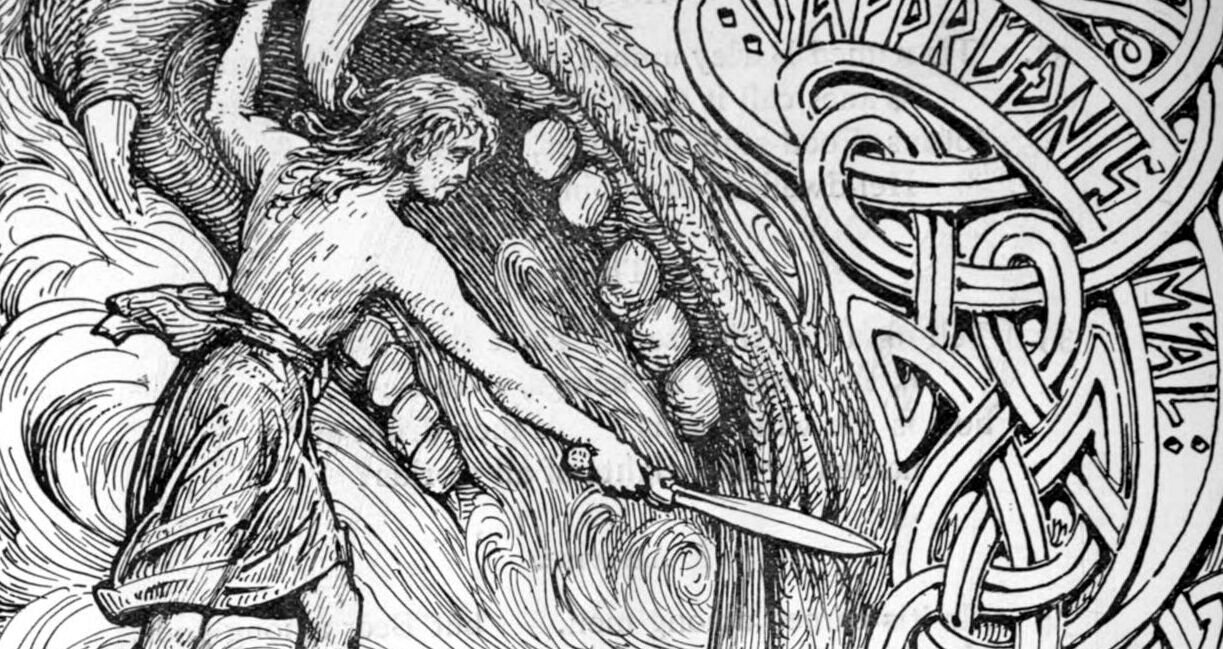Vidar (Víðarr), the son of Odin and Giantess Grindr, is one of the Æsir gods in Norse mythology. He is also known as the silent god. His most important role in the events of Ragnarök comes when he kills the main antagonist, Fenrir, thereby avenging his father's death. As a result, he is a god of vengeance.
Vidar: the God of vengeance
The words used to describe Vidar help us understand his character and importance. He is known as the god of vengeance, a title that also befits Vali, his brother.
Vali avenged Baldr’s death – many accounts suggest that he was born solely for this purpose.
Vali was born after Baldr’s death, grew up into an adult, and killed Hodr, Baldr’s killer, the same day. Hodr was Badr’s twin brother, who was blind. Loki had tricked him into killing Badr.
Several other kennings describe Vidar, including the silent god, possessor of the iron shoe, and slayer of Fenrir. Besides being the avenger, Vidar is the one who occupies his father’s homestead.
Although Vidar’s name means “widely ruling,” the powers associated with him don’t have anything to do with it. He is an excellent fighter with great strength. Only his half-brother, Thor, is described as having greater strength than him.
Also known as the god of the thick shoe, Norse myth describes him as someone who’s always adding pieces of leather to his shoe.
He picked off-cuts that shoemakers would throw away and used them to reinforce his shoe. It was in preparation for Ragnarök when he stepped onto Fenrir’s huge lower jaw and used his hand to push onto Fenrir’s upper jaw and tear apart his jaws.
Some versions of Norse myth refer to him as the owner of the iron shoe.
Why is Vidar Silent?
Unlike Thor, whose description shows a boastful god, Vidar is the silent god. It is one of the factors thought to be the connection between Vidar and vengeance. Since vengeance is considered a quieter form of violence, the rituals involved are conducted in silence (it could be a form of cleansing).
When the Vikings made offerings to Vidar, they would bury weapons in cold water or ice. The idea revolves around vengeance being a cold form of violence.
The silent god was also associated with wilderness. He spent a lot of time by himself, interacting with nature. His hall was known to be where brushwood grows, and the grass is said to be high.

Is Vidar a Strong God?
Vidar is a strong god, and his enormous strength comes to play when he kills Fenrir to avenge his father’s death.
According to an earlier prophecy, many gods were bound to die during Ragnarök – the battle that would end the world. The forces of Loki and the giants would battle it against Odin and the Æsir gods.
The prophecy predicted that the mighty wolf Fenrir, son of Loki, would kill Odin. And since the gods feared the destruction that Fenrir would cause, they tricked him and chained him on a deserted island to prevent him from doing harm.
As Ragnarök approached, the events leading up to the battle would enable Fenrir to free himself from the shackles. He would then set up to go around the nine worlds of the Norse universe, his powerful open mouth devouring everything. He would find Odin and devour him too.
As the avenger of his father’s death, Vidar would use his thick, enchanted shoes to step onto Fenrir’s lower jaw and stamp it down. He would use his strength to hold the giant wolf’s mouth open and pierce his sword through Fenrir’s throat and into his heart. Fenrir would die on the spot.
The Importance of Vidar in Norse Mythology
Vidar is an important god in Norse mythology since he plays a crucial role during the events of Ragnarök.
By avenging Odin’s death, Vidar saved the nine worlds of the Norse universe from ultimate destruction.
With the old Norse gods all dead, the new ones set out to continue the legacy of Odin, the all-father. Vidar pulled together the sons of Thor and the other gods that survived Ragnarök and began restoring the damaged Asgard and rebuilding a new world.
Away from mythology, at least two places in the Scandinavian region contain Vidar’s name. Virsu (from Vidarshof), meaning Vidar’s temple, and Viskjol (from Vidarsskjalf), representing Vidar’s pinnacle. In modern Norway, it shows Vidar’s importance among the Vikings.
Snorri Sturluson, a 13th-century Icelandic chronicler, compares him to Aeneas, who survived the Trojan war.

